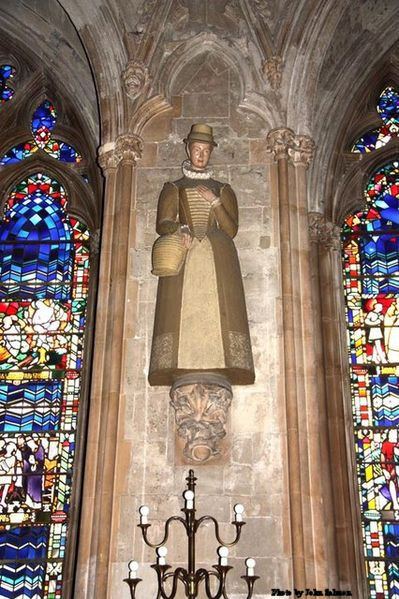St. Margaret Ward
Nave statue St Margaret Ward inside St Etheldreda Church in Ely Place, London.
Martyr, born at Congleton, Cheshire; executed at Tyburn, London, 30 Aug., 1588. Nothing is known of her early life except that she was of good family and for a time dwelt in the house of a lady of distinction named Whitall then residing in London. Knowing that William Watson, the priest who wrote the work known as the “Quodlibets”, was imprisoned, she obtained permission to visit him.
After several visits she disarmed the vigilance of the gaoler and furnished him with a cord whereby he could make his escape.
At the appointed time the boatman whom she had engaged to convey the priest down the river refused to carry out his bargain, and in her distress she confided her difficulty to a young man, Ven. John Roche (or Neele), who undertook to assist her. He provided a boat and exchanged clothes with Watson, who made good his escape.
But the clothes betrayed John Roche, and the rope convinced the gaoler that Margaret Ward had been instrumental in the flight of the prisoner. They were both arrested and loaded with irons. Ven. Robert Southwell wrote to Father Acquaviva, S.J.:
She was flogged and hung up by the wrists, the tips of her toes only touching the ground, for so long a time that she was crippled and paralyzed, but these sufferings greatly strengthened the glorious martyr for her last struggle.
She was tried and condemned at Newgate, her liberty being offered her if she would attend Protestant worship.
newgate cell
YEPES, Historia Particular de la persecucion de Inglaterra (1590); CHALLONER, Memoirs of Missionary Priests (London, 1741-2); POLLEN, Acts of English Martyrs (London, 1891); Catholic Record Society, V, 323, 327; The Month (Jan., 1879).
EDWIN BURTON (Catholic Encyclopedia)
[Note: She was canonized on October 25, 1970 as one of the Forty Martyrs of England.]




No comments:
Post a Comment